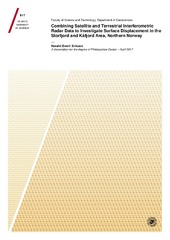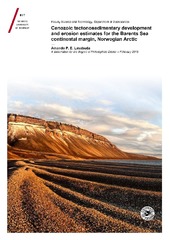Combining Satellite and Terrestrial Interferometric Radar Data to Investigate Surface Displacement in the Storfjord and Kåfjord Area, Northern Norway.
Permanent lenke
https://hdl.handle.net/10037/11679Åpne
Thesis (PDF)
Paper 1: Eriksen, H.Ø. et al. (2017). Visualizing and interpreting surface displacement patterns on unstable slopes using multi-geometry satellite SAR interferometry (2D InSAR). Also available in Remote Sensing of Environment 2017, 191:297-312. (PDF)
Paper 2: Eriksen, H.Ø. et al. (2018). Abrupt Increase in Permafrost Creep Rates Following Climate Change. (Manuscript). Published version with title “Recent Acceleration of a Rock Glacier Complex, Ádjet, Norway, Documented by 62 Years of Remote Sensing Observations” available in Geophysical Research Letters, 45(16), 8314-8323. (PDF)
Paper 3: Eriksen, H.Ø. et al. (2017). Relating 3D surface displacement from satellite- and ground-based InSAR to structures and geomorphology of the Jettan rockslide, Northern Norway. (Manuscript). Published version available in Norwegian Journal of Geology, 97(4), 283-303. (PDF)
Paper 4: Eckerstorfer, M., Eriksen, H.Ø. et al. (2018). Comparison of geomorphological field- and 2D InSAR mapping of the periglacial landscape at Nordnesfjellet, Northern Norway. (Manuscript). Published version with altered title available in Earth Surface Process and Landforms, 43(10), 2147-2156. (PDF)
Dato
2017-10-10Type
Doctoral thesisDoktorgradsavhandling
Forfatter
Eriksen, Harald ØverliSammendrag
Due to their all-weather all-day capabilities and increased availability, synthetic aperture radar (SAR) interferometric displacement datasets have gained popularity in a variety of scientific disciplines. Both satellite and ground-based platforms are used. Satellite-based radar instruments cover large areas on a regular basis without the need for in-situ instrumentation. As with all measuring techniques, radar has its limitations. One intrinsic property is its ability to only observe displacement along the Line-Of-Sight (LOS) direction, thus displacement components diverging from the LOS-direction are underestimated, which limits interpretation of displacement processes. Being portable, the LOS-direction of ground-based radars can be selected. However, as with the satellite-based instruments, ground-based radars still suffer from underestimation of displacement that arises due to divergence from the instrument’s LOS-direction.
In this project, we have combined multi-geometrical radar datasets from ground- and satellite-based radar to form two-dimensional (2D) and three-dimensional (3D) surface displacement vectors, creating new ways to interpret surface deformation. By plotting the resulting 2D and 3D surface displacement vector datasets in map and cross-sections, we interpret displacement at the landform- and landscape-scale.
Using 2D surface displacement vectors produced from scenes acquired by the TerraSAR-X satellite in ascending and descending orbits we have studied rockslides, rock glaciers and solifluction lobes at the landform scale. In addition, we have investigated the use of periglacial landform-specific displacement rates as a tool for geomorphological mapping at the landscape-scale. By also including data from ground-based radar we have calculated 3D surface displacement vectors for the Jettan rockslide. In contrast with single radar datasets, using 2D and 3D surface displacement vectors together with topography enables us to calculate different kinematic diagnostic parameters that can be used as tools for interpretation of displacement patterns. Variations in kinematic diagnostic parameters such as combined displacement velocity, azimuth, dip/plunge, displacement into and out of the slope (subsidence/ uplift), compression/extension (strain rate) and horizontal and vertical components, when plotted in cross-sections, enables us to discuss the processes and, factors controlling observed deformation patterns. The 2D and 3D surface displacement vector datasets produced in this work act as an important contribution together with geomorphological, structural and field data for proposing geological models.
Forlag
UiT Norges arktiske universitetUiT The Arctic University of Norway
Metadata
Vis full innførselSamlinger
Copyright 2017 The Author(s)
Følgende lisensfil er knyttet til denne innførselen:
Med mindre det står noe annet, er denne innførselens lisens beskrevet som Attribution-NonCommercial-ShareAlike 3.0 Unported (CC BY-NC-SA 3.0)
Relaterte innførsler
Viser innførsler relatert til tittel, forfatter og emneord.
-
Cenozoic tectonosedimentary development and erosion estimates for the Barents Sea continental margin, Norwegian Arctic
Lasabuda, Amando Putra Ersaid (Doctoral thesis; Doktorgradsavhandling, 2018-04-26)The Barents Sea shelf has been experienced extensive uplift and erosion in the Cenozoic. However, the pre-glacial erosion has been so far less constrained in comparison to the glacial erosion. This paper aims to better understand the early–middle Cenozoic erosion in the western Barents Sea and the late Cenozoic erosion in the northern Barents Sea by using the mass-balance approach. The study utilizes ... -
Slope displacement patterns observed using satellite InSAR data in the Storfjord-Kåfjord-Lyngen region, Troms
Eriksen, Harald Øverli (Master thesis; Mastergradsoppgave, 2013-05-15)Norway is particularly susceptible to large rockslides due to its many fjords and steep mountains. One of the most dangerous hazards related to rock slope failures are tsunamis that can lead to large loss of life. Many rockslides are clustered east of the Storfjord and Lyngen fjord in Troms county, northern Norway, where several mapped unstable rock slopes occur within the zone of sporadic permafrost. ... -
On Roald Amundsen’s scientific achievements
Blix, Arnoldus S (Journal article; Tidsskriftartikkel; Peer reviewed, 2017-01-25)This paper describes the significant direct and indirect contributions to science made by the Norwegian polar explorer Roald Amundsen in the period 1897–1924. It documents that his expeditions through the North-west Passage (1903–06) with Gjøa, to the South Pole (1910–12) with Fram and through the North-east Passage (1918–1920) and the Chukchi and East Siberian seas (1921–25) with Maud yielded vast ...


 English
English norsk
norsk



